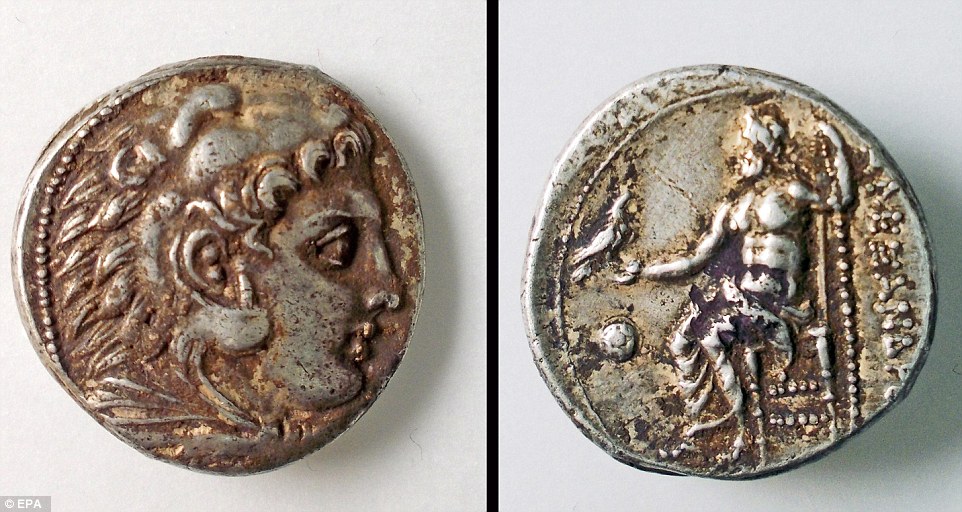令人感兴趣的谜继续包络保罗墓的故事. 居住者的性别是什么? 墓被当密封的? 这座纪念碑的建筑师是谁? 这幅画描绘了什么事件呢? 本文就来揭开他们所有.
居住者的性别是什么?
还有一次绝佳的机会,最终通过骨架对承诺的实验室调查未来几个月时间将回答这个问题. 然而, 卡捷琳娜 · 派里斯泰里, 基坑开挖的头, 在 11 月 29 日确认在文化部的演示文稿,没人目前有任何想法骨骼的性别, 因为骨头太多的考古学家能够检查确定性别的特征碎片,因为尸体与周围的土壤仍部分包围他们最好为了保全证据进行实验室调查. 然而, 她重复她先前的观点,居住者最有可能是一位男性和亚历山大的将军之一基于事实一次站在投手丘顶上,保罗狮子是男性,其基础装饰着盾.
这种想法并不新鲜, 但自从狮子纪念碑的片段被重新发现了一个多世纪以前,一直是学者的标准理论. 部件的防护板可以清楚地看到一些现在存储在附近保罗重建的狮子纪念碑附近的块 (图 1).
 |
| 无花果. 1. 从一次加冕喀斯特丘狮子纪念碑的盾的一部分与块 |
可是真的是雄性狮子和盾牌的纪念碑一定是为了纪念一个人? 保罗墓内它发生,两名皇家妇女在战争中发挥了主导作用. 首先, Adea 欧利蒂丝, 孙女亚历山大是父亲的谁, 菲利普 ·, 由嫁给 PhilipArrhidaeus 成为了女王/王后在 321BC, 亚历山大的弱智的同父异母兄弟, 投票选出部队曾在巴比伦君主亚历山大的死亡. 在 317BC Adea 试图战胜官方联合国王的优先级为她的丈夫, 亚历山大四世, 亚历山大大帝的 6 岁儿子. 这促使亚历山大四世祖母, 奥林匹亚, 伊庇鲁斯,往马其顿去捍卫她的孙子的权利,翻山越岭,带领她的侄子 Aeacides 的军队. 阿忒那奥斯 560f 描述的情况: "第一次的战争,两个女人间的斗争是奥林匹亚和 Adea 欧利蒂丝之间发动, 在此期间奥林匹亚打扮相当喜欢 Bacchant, 击鼓伴奏, 而 Adea 欧利蒂丝从头武装到脚的马其顿时尚, Kynna 训练在军事活动中, 伊利里亚的公主 [和菲利普二世的妻子]."奥林匹亚战胜国和收到绰号 Stratonike, 意思是"军队的胜利女神". 盾牌一座纪念碑将是完全适合任一这些皇后.
奥林匹亚也声称对狮子作为个人徽章作为普鲁塔克, 亚历山大的生活 2.2 记录: "之后他们的婚姻, 菲利普梦见他在奥林匹亚的子宫里把一只海豹, 和密封装置, 随着他想象的, 是一只狮子的人物. 另一些预言家被带领了怀疑菲利普需要保持对自己的婚姻关系更为密切的关注; 菲特以 Aristander 说这个女人怀孕了,但, 既然一只海豹不放在那是空的, 和怀孕和其性质将大胆和狮子一样的儿子。
 |
| 无花果. 2. 亚历山大将军在托勒密铸造 tetradrachm ~ 310BC 与雅典娜一个拿盾牌和挥舞着一根长矛 |
马其顿人在当时的银币也见证了战士的新现象妇女. 在埃及, 亚历山大的前将军, 托勒密, 铸造银 tetradrachms 形象神化的亚历山大穿着大象头皮的正面和智慧女神雅典娜表示一系列轴承防尘盖,挥舞着一根长矛的背面 (图 2). 甚至有可能托勒密介绍这种逆转承认在他的故乡马其顿女王之间的战斗, 因为它最早出现在一年或两个事件. 虽然不能正确地女神像女神雅典娜, 奥林匹亚是上帝的正式的母亲在她去世的时候: 举个例子, 托勒密的硬币上的神化的亚历山大介绍了在 321BC. 此外, 亚历山大亲自录得要有希望,使他的母亲,在她死后,一位女神 (柯 9.6.26-27). 最后, 由此我们知道女王的称号奥林匹亚不是她原来的名字 (那大概是攻占, 虽然她后来也被称为 Myrtale), 但是尊称的意思"之一从奥林匹斯女神"颁发给她由国王菲利普在她生下了亚历山大的时候了.
 |
| 无花果. 3. 腓力二世之墓的接待室的战士武器推定为女皇葬在同一个房间内的财产. |
此外, 腓力的妻子之一, 也许 Meda, 被埋在他墓林尼吉纳的接待室. 历史学家现在认为,发现在前厅的武器属于这个女王,而不是菲利普 ·. 他们包括金色装甲 (箭头箭) 和格里夫斯 (较低的腿甲) — — 见图 3.
它还应该强调,在保罗实际墓分庭内所有符号的装饰品都是毫不含糊地女性性格: 狮身人面像, caryatids/klodones 和珀耳塞福涅在马赛克图.
出于所有这些原因, 它不会为了马其顿女王和奥林匹亚特别是由饰战士盾牌顶保罗在投手丘上的狮子纪念碑纪念令人惊讶. 它因此是皇后的特别有趣的是皇后的我们听闻从卡捷琳娜 · 派里斯泰里在演示文稿上周六 11 月 29 日她部分已经启发的故事从当地的人民,这是皇后的一个著名墓挖喀斯特丘. 有时这种传说海港胚芽真相.
 |
| 无花果. 4. 放在狮子纪念碑在保罗从捞起的石头旁边空石棺 |
此外,还有另一种诱人的可能性: 那个亚历山大将军实际上被埋葬在狮子纪念碑除了下方的土墩墓内. 还有一个明显的候选. 亚历山大的八个 somatophylakes 之一, 国王的最高级参谋人员, 一个名为 Aristonous 的马其顿, 谁是她与西马科战争中奥林匹亚的军队指挥官的并且也是保罗,这位敬爱耶和华吗. 但翌年安排他谋杀在大约同一时间,他已经死亡的奥林匹亚. 一个有趣的观察是石棺被打捞从存放在当前部分的狮子纪念碑的石头和一批重建狮子 (图 4). 我有没有确认目前是否它本身就是确实从纪念碑, 但这肯定是值得考虑将来的调查.
墓被当密封的?
了解保罗墓的历史批判性取决于确定何时和通过集约型密封操作进行了谁. 密封巨大的墙壁, unmortared 的块看似取自 peribolos 墙被竖立在这两个门廊前和在狮身人面像和所有三个分庭内刻意都挤满了从附近的河里斯特里蒙床挖沙. 11 月 29 日的发言证实,砌体附近水平的拱形天花板上的洞被用于入内部运砂后密封墙竖立起来了,不由抢劫者.
然而, 于 11 月 29 日发表的最令人感兴趣声明是由建筑师 Michael Lefantzis, 据报道,谁是说做密封墙和回填在罗马时代完成, 同时也确认密封墙被从从这座纪念碑的另一部分中移除材料制造.
 |
| 无花果- 5. 古代漆上下方狮身人面像立壁的首都 |
考古学家还说墓在向中外游客开放一段时间并密封的罗马可能采取暗示墓参观至少几个世纪以来发生. 然而, 考古学家和文化部先前已经公布了一些证据, 主要摄影, 这可能意味着墓只是开放的相对较短的时间之前被关闭:
1) 古代油漆在门面上幸存下来, 例如在首都的壁柱两侧下方狮身人面像门户 (图 5). 优惠应预期风化的外墙涂料,几个世纪的风化会通常完全删除油漆, 但立面上的油漆在没有更糟的条件比第一会议厅内涂料.
 |
| 无花果. 6. 块体密封隔离墙前的狮身人面像门户显示块不被一起砖头他们删除期间 |
2) 砌体密封墙不被砖头, 但石头只是堆叠在另一个 (图 6). 这是希腊化时期的正常, 但罗马人几乎总是用砂浆把石头在他们的墙壁之间.
3) 有几个公布的照片中的古代步骤 (例如. 图 7): 虽然还有一些崩到这些步骤的边缘, 他们不过是仍然锋利, 酥和其边缘的中央部分公寓. 几个世纪以来应预期的磨损模式顺利.
 |
| 无花果. 7. 与它依旧清脆和还没穿破的边缘部分的大理石碎片中无明显的磨损和古代步红水泥地板. |
4) 在第一庭既不铺路 (图 7) 也在第二分庭马赛克 (图 8) 差速器到地区地方游客会主要有踩穿任何迹象表明 (对该中心所需的马赛克的损害必须已到期时密封或只是在事件前, 因为据报道在开挖过程中的到位仍发现有松动。)
 |
| 无花果. 8. 珀耳塞福涅马赛克毗邻第二室的入口处的部分展品磨损的迹象 |
可能有一些这些点的答案: 例如. 建议入口处有一个屋顶在它 (虽然这将使内部的分庭 2 非常黑暗). 然而, 集体有墓分庭不可能一直向作为长一样的世纪对游客开放的两点启示.
另一个难题与罗马时代密封是动机的问题. 它会一直既昂贵又耗时建密封墙,疏通和运输数千吨的沙子. 还, 因为没有严重的货物,留, 可能在该坟墓内只是值的骨骼本身. 但这些骨头被抛出严重插槽散落. 如果封口机关切地保护骨骼, 为什么做他/她不收拾他们封口墓前?
简单的方法,以消除疑虑的密封的日期就是宣布在狮身人面像前竖立的密封墙内发现的罗马约会证据. 事实上卡捷琳娜 · 派里斯泰里 11 月 29 日说有没有陶或在主燃烧室中的硬币, 但是,考古学家发现了很多其他领域: "在主燃烧室中我们并没有任何随葬品. 他们已被移走或他们也许是在别的地方. 我们正在做的土力工程处调查可能会给我们更多的信息,关于什么可能是有其他地方, 但在其他方面 (ΧΩΡΟΙ) 我们有陶器和钱币正在清理和研究. 我们只是还没有向你展现他们. 约会是在第四世纪公元前在某一阶段的最后一个季度,我们有从 2 世纪公元前硬币, 这是时代的最后的马其顿人,以保护他们的纪念碑和从公元 3 世纪的罗马年"不幸的是, 这仍然是含糊不清的任何这种证据是否竖立在狮身人面像前的密封墙内发现问题.
因此, 现在关键的问题是: 什么是最新的归因日期的任何数据表竖立在狮身人面像前的密封墙内发现? 在一般情况下, 最新数据表的材料很可能是一个好的征兆,当墓被最后密封. 是否任何东西肯定罗马已找到里面那堵墙, 然后最后密封是很有可能罗马. 在这种情况下墓只被轻轻地访问了平行的证据可能意味着密封的历史是相当复杂, 也许涉及早期的密封, 稍后的开幕式和最后重新密封.
这座纪念碑的建筑师是谁?
保罗墓考古队此前纷纷猜测其建筑师的身份和在 11 月 29 日星期六他们介绍他们确认整个纪念碑是除了 cist 坟墓和其插槽的单一建筑师的工作, 这是现已证实前日期其余的纪念碑. 我很有信心的考古学家们对这些要点.
 |
| 无花果. 9. Deinocrates 到亚历山大的建议,阿陀斯山雕刻成他的形象 |
最有趣的名字使考古学家们关于这座陵墓设计师的身份是建筑师的亚历山大, Deinocrates (从字面上"奇迹大师"). 他在古代文献中广泛引用,也被称为 Cheirocrates ("手大师"), Stasicrates, Deinochares 和甚至晋身. 表明 Stasicrates 是他的真实姓名和 Deinocrates 是一个绰号. 他是该项目的投标人要到亚历山大巨型雕像造型阿陀斯山, 虽然这由国王拒绝了 (见图 9). 他被指定为已还原在以弗所和普鲁塔克的阿尔忒弥斯神庙 (亚历山大 · 72.3) 为设计和施工的赫的火葬和纪念碑写亚历山大是"渴望的 Stasicrates". 最有名的所有, Deinocrates 是在埃及亚历山大的亚历山大的建筑师. 在我的书, 亚历山大大帝的墓寻求, 2nd 版, 2012, 临 160, 我做了砌体墙的亚历山德里亚的最古老碎片和保罗狮子墓之间的联系 (即. 从支持狮子的结构块, 这是所有在那个时候知道):
"块的石灰石中最古老的这个片段部分 [古代亚历山大城的墙壁, 位于现代的 Shallalat 花园] 挤满了壳化石和最大有一米宽的石头, 尽管他们各不相同的大小和比例. 他们有他们的边缘周围起草一个独特乐队, 但每一脸剩余粗. 在亚历山德里亚的罗马人塔面临着块相同的样式, 包括起草的乐队.
这种块都尤其在较高的地位早期希腊架构上下文中找到. 其他一些相关的实例包括衬狮子墓 Knidos 和另一只狮子墓从保罗在马其顿的原基块的块. 这两个最可能时间大约在公元前四世纪的结束和亚历山大的直接继承者与最佳关联。
 |
| 无花果. 10. 最古老的其余片段的亚历山德里亚的墙壁 (以上) 保罗丘第 peribolos 墙身出现起草块边缘块作为同一频段 (下面). |
亚历山德里亚的块从最古老的城墙幸存部分也是媲美的块中 peribolos 墙现在发现在保罗. 与在其中央的保留方面被甩粗的石头都起草块边缘周围的独特乐队 (图 10).
 |
| 无花果. 11. 古代亚历山大城地图的基础在掘路工程 1865 由马哈茂德贝. |
考古学家们提出了一个稍微复杂的论点,支持在 Deinocrates 建立了保罗墓基于地图的古代的亚历山德里亚 (图 11) 绘制由马哈茂德在贝 1866 整个古城的网站后他广泛的挖掘中执行 1865. 马哈茂德重建基于结果许多挖掘地点的街道网格. 他推断出体育场的大小, 大距离希腊衡量标准, 注意到离职的街道网格的道路被固定的这个数字已经 165 米的亚历山德里亚.
他还重建古城墙在东部和南部两侧挖掘的基础上的课程, 但在西部和在某种程度上北侧他不得不猜测他们在很多地方的课程, 由于现代的事态发展作出必要开挖网站无法访问. 他想出了整体的外围墙壁的 96 亚历山大个或 15.84 公里 (尽管马哈茂德自己实际上在他的书中写道"约 15 800 米"。)
注意到保罗考古学家亚历山大墙电路的马哈茂德贝, 他们应该有计划乘 Deinocrates, 几乎完全是由其循环 peribolos 墙一百倍的喀斯特丘直径, 他们有测量 158.4 万. 他们认为这种巧合表明 Deinocrates 是建筑师保罗墓以及对于亚历山德里亚.
然而, 有几个困难这一假说:
1) 有三个古代的作家给周边的亚历山德里亚的墙: 在柯 80 这个, 在普林尼 15 英里,在 Stephanus Byzantinus 110 这个. 所有这些都是明显不同于现代 15.84 km 值从马哈茂德贝.
2) 这是令人怀疑是否所有的马哈茂德的墙线, 尤其是在西方国家, 能准确, 因为目前为止,他没有实际上发现在他重建的外围大片墙的任何明确的痕迹.
3) 这是令人怀疑是否外墙映射由马哈茂德贝亚历山德里亚 Deinocrates 的原始计划的一部分. 这是本质上是城市在其全盛时期大约的奥古斯都时代的墙线. 它不太可能亚历山大成立,该镇 5 公里宽, 因此,它将需要 50 万居民来填满它. 现在幸存的只有片段的早期的托勒密墙是在一个更小的电路线, 中部的马哈茂德的城市,包括其中央的十字路口. 这是更适合于 Deinocrates 的杰作.
4) 要比较的周长与直径两者的不一样. 它是度量的大型单位, 法兰西体育场, 这真应亚历山德里亚和保罗墓喀斯特丘之间比较.
通常在希腊城市中体育场被定义为测量 600 脚. 所以对于, 示例, 在雅典 stade 原本是 185 米. 然而, 亚历山大大帝的雇用被称为 bematists 的男子 (从字面上"步行者") 要他通过对他的运动的城市与城镇之间的距离测量. 我们仍有一些城镇和它们作为测定亚历山大的 bematists 之间的距离的名单 (称为 stathmoi 或"阶段"). 因为很多地方在这些列表中有已知位置今天就可以从现代地图中计算出了多长时间使用的亚历山大的 bematists 体育场必须和答案是 157 米 (看到 Fred 霍伊尔, 天文学, 拉斯伯恩图书有限公司, 伦敦 1962.) 这就要求一英尺的只有 26 厘米, 这将非常小,而且远远低于正常范围内. 但它当然不切实际的 bematists 来测量数百公里的把他们的脚脚跟到脚趾反复下来的城市之间的距离, 因此,他们必须有用于步代替脚定义他们的体育场. 事实上我们知道罗马英里被定义为 1000 步伐和为 1481 米, 所以很可能,亚历山大 bematists 使用的体育场 100 步伐 (两个步骤,每个步伐). 不管怎么说, 很明显在保罗的喀斯特丘直径实际上非常接近由亚历山大的 bematists 使用的体育场. 而实际上 165 米亚历山大体育场是接近 bematists 的体育场,比对其他城市 600 英尺体育场. 结论可能是亚历山德里亚的建筑师和设计师的保罗墓用步子量出一种类似于亚历山大的 bematists 的方式对其计划. 所以有一个轻微的链接毕竟是 Deinocrates 之间, 著名的建筑师的亚历山德里亚, 和建筑师保罗墓.
此外, Deinocrates 是与旨在给人印象不寻常大小的项目相关联, 所以这是另一个好理由认为 Deinocrates 是在喀斯特丘的应聘者. 我们当然可以说一个杰出的希腊建筑师设计了喀斯特丘和其狮子墓 100 为了刻意讨好通过大小和计划的大小正好之一亚历山大的 bematists 个步伐直径.
Deinocrates 因此仍然是建筑师保罗狮子墓的身份的合适人选. 然而, 证据是很大程度上依情况而定,特别是依靠墓可以追溯到公元前 4 世纪的最后一个季度的正确性. 我认为没有理由怀疑这约会和考古学家调用样式和镶嵌在他们的发言在 11 月 29 日,以支持人为他们四世纪末 BC 日期上执行. 然而, 我们需要看到更多一点的约会证据必须绝对有信心在向狭窄的四分之一世纪时隙分配墓.
 |
| 无花果. 12. 一个男人和一个女人穿着红带两侧的公牛在一幅画舞从保罗墓的墓室 |
这幅画描绘了什么事件呢?
希腊文化部发布最近发现装饰在第三个枋画的照片 (埋葬) 分庭的保罗墓在 12 月 3 日 2014. 他们描绘了一个男人和一个女人穿着红色的皮带或腰带他们跳舞一头公牛的任一侧的腰 (图 12) 高大的金塔和大锅或在三脚架上的火盆之间一翼女 (图 13). 新闻发布会上也提到在会议厅大理石屋顶梁都涂上了莲座丛.
 |
| 无花果. 14. 有翼的女人之间一大缸和一个火盆上绘画从保罗墓的墓室中的高鼎 |
这些场景似乎与某种邪教活动相关联,我会告诉有重大相似之处,与我们所知道的在一个特定的邪教网站的活动: 伟大的神灵对女神的避难所, 女神的奥秘在哪里进行. 这个岛的圣所被长时间光顾王室的附近马其顿和保罗墓的时代, 公元前 4 世纪的最后一季, 那乘客特别被链接到女王/王后奥林匹亚. 值得注意的是普鲁塔克, 亚历山大 · 2.1 写入: "我们被告知,腓力, 后正在发起在奥林匹亚同时进入在女神的奥秘, 他本人还被一个青年
和她一个孤儿的孩子, 与她坠入爱河和许配给本人给她一次她的哥哥同意, Arymbas"。
 |
| 无花果. 14. 花团锦簇的公牛头与从伟大的神灵对女神的圣阿尔圆形大厅一莲座丛中楣. |
与未解之谜的女神的第一次连接是公牛祭祀与莲座丛的组合. 还有浮雕从公元前 3 世纪阿尔大厅在上女神圣殿, 描绘两个花环簇拥的公牛头两边的一大 8 瓣莲座丛 (图 14). 已假定它暗示到了牛市期间未解之谜的牺牲. 其实众所周知仪式的一段涉及到动物的牺牲,这是一定在古罗马时期这项包括公牛牺牲. 它因此相当惊人的新发现的画作描绘在分庭也用类似的花环装饰方面的可能的公牛牺牲.
 |
| 无花果. 15. 胜利的女神从伟大的神的圣所 |
第二个连接来自圣上与耐克女神很强协会, 具翅的胜利女神. 最著名的, 精彩的"胜利女神", 现在在卢浮宫里 (图 15), 今年 3 月由查尔斯 Champoiseau 发现在粉碎在圣所中被破坏的寺庙建筑之一的伟大的神灵 1863. 此外还有献给女神圣拉里萨在色萨利的发现伟大的神灵许愿碑
Heuzey 和多梅远征 (图 16) 和那太描绘其组成的核心部分的胜利女神奈基. 在早期的希腊化时期的希腊艺术中的翅的女人通常是耐克描写, 所以我们可以合理地假设新发现画中有翼的女人也是胜利女神.
 |
| 无花果. 16. 发现在拉里萨致力于包括有翼女神耐克中央描绘的伟大女神神碑 |
众所周知,以及一些之谜的女神仪式发生在夜里. 基金会在女神圣殿内神庙被寻回, 它可以支持一个巨型的火炬, 但也许新发现画中的高大火盆之类能履行照亮夜行性仪式的功能. 更普遍, 许多灯和火炬支持整个伟大的神的圣所发现证实入会仪式的夜间性质. 此外, 它被怀疑女神的提升者被许诺了快乐的来世, 由于也是在进行在雅典附近的神秘案件. 这将使场面从女神龙之坟墓的装饰精品课程的奥秘.
最后, 也许最引人注目的是, 我们知道从古代的报告 (例如. 瓦罗的神圣古物) 在女神的奥秘的一个特点是修戴在腰间的红色腰带. 它因此是公牛的相当值得一看只是公牛的这种红色的腰带,腰的男人和女人保罗在墓室中新发现的画作的舞两边.
如果这些墓室壁画和神秘女神之间的关联,则, 然后,这提供了另一种有力地表明保罗墓的主人可能是奥林匹亚, 亚历山大大帝的母亲.
作者
安德鲁 · 格






























